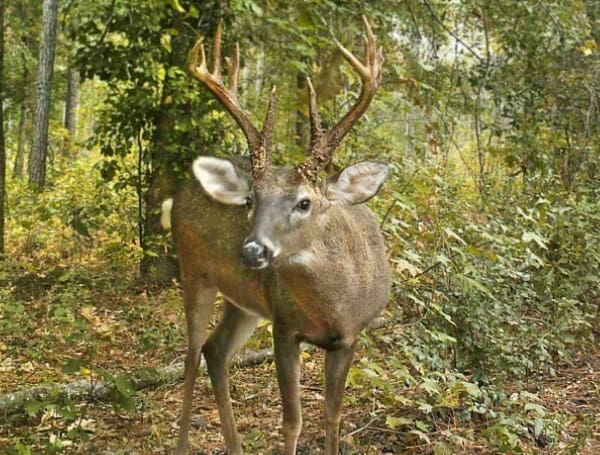Data about the impact of the Florida Fish and Wildlife Conservation Commission’s (FWC) deer antler point regulations suggest progress is being made in an area important to most deer hunters – more opportunities to see and harvest larger antlered deer.
FWC biologists reviewed check station information from more than 40 wildlife management areas to analyze data from before and after antler point regulations went into effect in 2014 and 2015 on private and public lands, and WMAs statewide.
The results of that analysis showed a shift in the age structure of harvested antlered deer with a 23% decrease in the harvest of 1.5-year-olds.
Allowing yearlings a chance to grow and mature contributed to increases in the harvest of older age class deer. During this same period, the average number of antler points increased 22% from 4.9 to 6.0. (Statewide, the average number of antler points steadily increased to 6.7 after antler points regs were implemented, based on data from the FWC’s annual harvest survey.)
In addition, the antler index, which expresses antler quality, also increased 20%.
The data also showed more venison for the table. The average live weight of deer increased 5.5%, from 109 pounds before antler point regulations were implemented to almost 115 pounds after they went into effect.
The FWC manages whitetails at the deer management unit level, tailoring antler point regulations (and other rules) based on habitat quality, characteristics of the local deer herd and stakeholder preferences.
Florida is divided into 12 DMUs, and eight of these units require all antlered deer to have at least three antler points on a side or have a main beam length of 10 inches or more to be legal to take.
The remaining four DMUs have a two-point-on-a-side rule. Find DMU-specific information, including antler point regulations at MyFWC.com/Deer and click on “Deer Management Units.”
Interested in finding where top scoring bucks were harvested in Florida? Check out the FWC’s interactive map, which shows Florida Buck Registry entries by county. Learn more by visiting MyFWC.com/Deer and click on “Buck Registry Interactive Map.”
Monitoring harvest information and hunter satisfaction
While science is the foundation of the FWC’s wildlife management efforts, hunter feedback also plays an important role.
The FWC will continue to monitor the results of antler point regulations, bag limit rules and more through its annual scientific survey of licensed deer hunters in Florida, which measures deer harvest as well as hunter participation and satisfaction.
Another important source of deer harvest data is obtained through the FWC’s requirements for hunters to log and report their harvested deer.
Don’t forget to log and report your harvested deer
Before you head afield this hunting season, make sure you have a plan to log and report harvested deer.
This regulation, which went into effect in 2019, requires ALL hunters, including those who are exempt from license requirements, to log their harvested deer prior to moving it from the point of harvest, defined as the spot on the ground where the hunter located the harvested deer.
In addition, they must report harvested deer: 1) within 24 hours of harvest, or 2) prior to final processing of the deer, or 3) prior to the deer or any parts of the deer being transferred to a meat processor or taxidermist, or 4) prior to the deer leaving the state, whichever occurs first.
You have options for logging and reporting:
- Option A – Log and Report (Steps 1 and 2) on a mobile device with the FWC Fish|Hunt Florida App or at com prior to moving the deer.
- Option B – Log (Step 1) on a paper deer harvest log prior to moving the deer and then report (Step 2) at comor Fish|Hunt Florida App or calling 888-HUNT-FLORIDA (888-486-8356) within 24 hours.
Learn more about how to log and report harvested deer at MyFWC.com/HarvestReport.
New rules to protect Florida deer from chronic wasting disease
Hunters always have been proud to contribute to conservation by providing wildlife management funding, introducing others to hunting, and reporting fish and wildlife violations to MyFWC.com/Wildlife Alert.
Another important way hunters can help is by adhering to the FWC’s new rules designed to reduce the threat of chronic wasting disease from spreading into the state and harming Florida’s deer populations. CWD is an infectious disease of the brain and central nervous system, and is always fatal for members of the deer family.
While CWD has been detected in 26 states, including most recently Tennessee, Mississippi and Arkansas, we’re fortunate it hasn’t been detected in Florida. And we need to do everything we can to keep it that way.
If you’re planning to hunt outside of Florida, be aware of new rule changes that prohibit importing or possessing whole carcasses or high-risk parts of deer, elk, moose, caribou and all other species of the deer family originating from any place outside of Florida.
Under the new rules, people may import into Florida:
- De-boned meat.
- Finished taxidermy mounts.
- Clean hides and antlers.
- Skulls, skull caps and teeth if all soft tissue has been removed.
The only exception to this rule is deer harvested from a property in Georgia or Alabama that is bisected by the Florida state line AND under the same ownership may be imported into Florida.
These rules went into effect July 1 and replaced FWC Executive Order 19-41. The new rules are similar to Executive Order 19-41 except they do NOT include a permit option to import whole deer or high-risk parts from properties located entirely in Georgia or Alabama.
Learn more about the new rule at MyFWC.com/Deer and click on “NEW Carcass Importation Rules.”
Support journalism by clicking here to our gofundme or sign up for our free newsletter by clicking here
Android Users, Click Here To Download The Free Press App And Never Miss A Story. It’s Free And Coming To Apple Users Soon.
